Hello new blog readers! I have been getting quite a few questions on string of hearts care over on my instagram so thought I’d refresh a post I wrote two years ago — I’ve added in some more tips I have found helpful in growing my string of hearts plants + getting them to thrive.
A beautiful hanging succulent plant that is also known as a rosary vine or chain of hearts, the ceropegia woodii is often seen tumbling off the bookshelves of Instagram. The internet has also been captivated by the newer addition of the variegated version which first appeared a few years ago + the ceropegia family in general seems to be ever-increasing in popularity too. If you are new to this plant, I’d suggest starting out with the regular version + not the variegated one, which needs brighter conditions to develop a pinky hue + can be a little more fussy. As the trend for hanging plants shows no sign of trailing off any time soon, I wanted to share some tips + tricks to help keep your hearts happy.

A bit of an experiment…



Above are some photos of my plant when it was younger… + please excuse the not-so brilliant photo quality here, these photos are a few years old! I have kept this plant in my bedroom — hanging off the picture rail next to my dressing table in one of my plant hangers. This has meant that I have been able to monitor its growth habits closely, for the purpose of writing this post. In addition to this string of hearts, I’ve been experimenting with a few of my plants I have multiples of (…perhaps the number one sign of being a plant hoarder?!) monitoring growth habits in different environments etc.
Did you know that the more light this ceropegia woodii receives, the closer together the hearts grow? You can see in this photo below, to the left are the strands that have been nearer the floor and received less light — therefore, more spaced out growth. To the right the hearts are closer together from receiving brighter light!
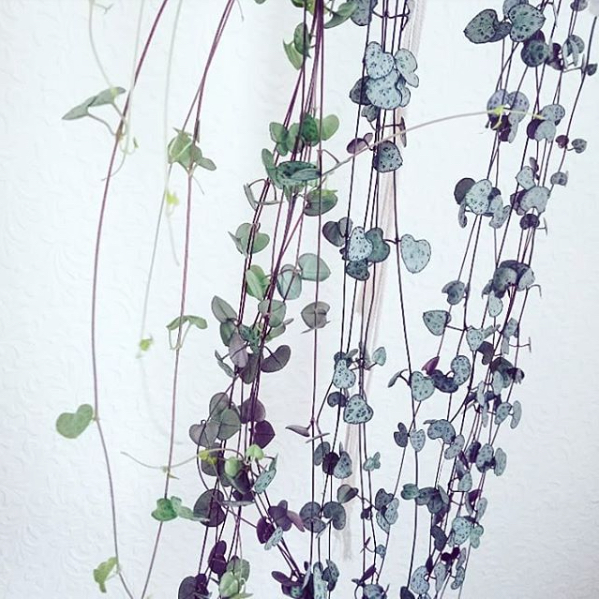
Here you can see the growth changes in one of my smaller string of hearts that I was keeping approximately one metre away from a west facing window — the hearts here were growing with an average gap of 3cm between hearts. After getting a new shelf in my kitchen, I moved it and it currently sits approximately half a metre away from my east facing french doors — the spacing between hearts has stretched out to 6cm. We can make a comparison here to the more commonly seen etiolated growth patterns of succulents that receive inadequate light levels such as echeveria for example — that make the succulents stretch for light. I have an extremely etiolated echeveria perle von nürnberg — see photo below…
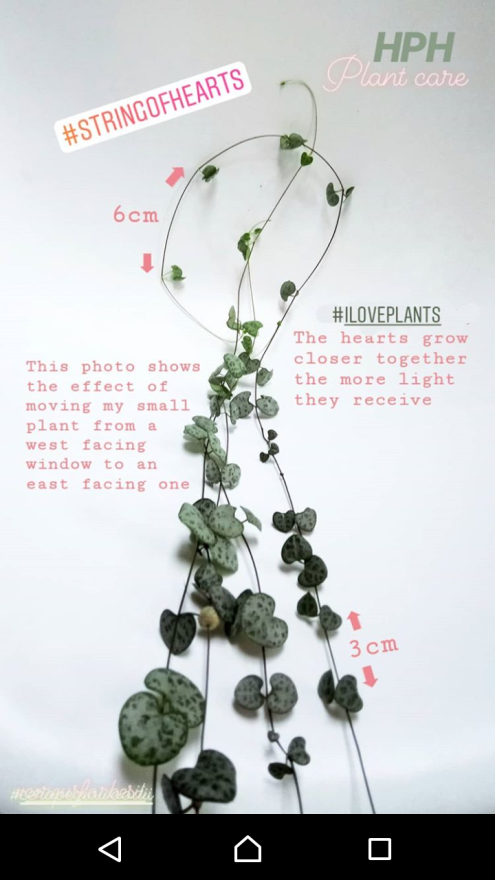
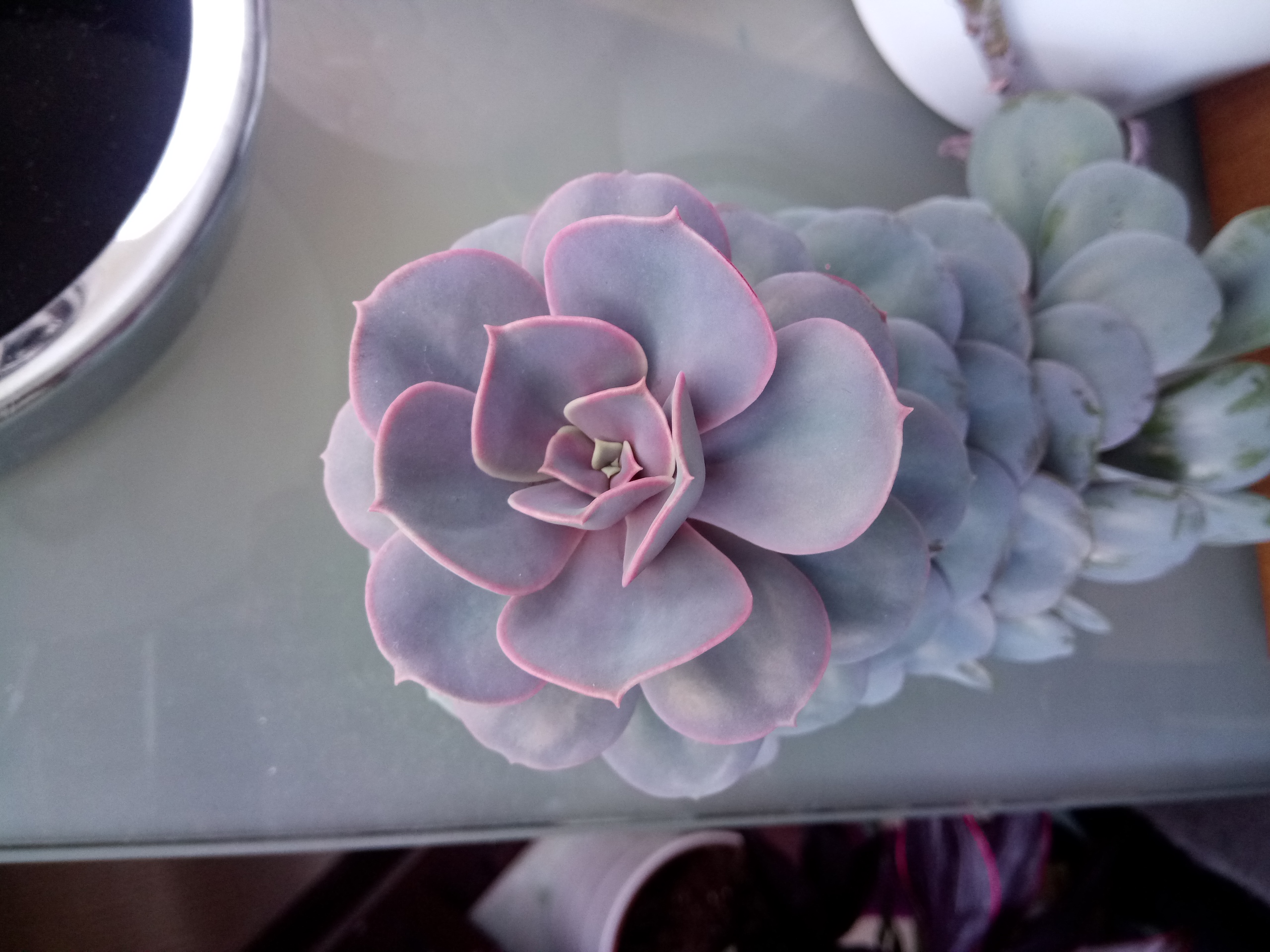
- etiolate, etiolated; etiolating
- to bleach and alter the natural development of (a green plant) by excluding sunlight
- to make pale
- to deprive of natural vigor : make feeble
- When we first started using “etiolate” in the late 1700s (borrowed from the French verb étioler), it was in reference to purposely depriving growing celery of light. The word traces back to an Old French word for “straw” and is related to the Latin word for “straw” or “stalk,” which is “stipula.” Nowadays the term for growing veggies as pale as straw is now more likely to be “blanch,” which can mean “to bleach (the leaves or stalks of plants) by earthing, boarding, or wrapping,” among other things. “Etiolate” is more apt to refer to depriving plants in general of light; when “etiolated,” they are sickly, pale, and spindly. The figurative sense of “etiolate” (“to make pallid or feeble”) first appeared in the 1800s as a natural outgrowth of the original sense.
SOURCE: https://www.merriam-webster.com/dictionary/etiolate
As a point of comparison, I wanted to show you my variegated hearts — you can notice the lighter leaves and white edges, that go a blush pink in sufficient light. Mine are still new so not much pink yet, but I will be sharing their growth progress over on my Instagram here.


Light
I’ve been growing my SOH plants for a few years now + in terms of positioning, I really do think I’ve found the perfect position for mine this year. So much so that when I move next, I’m going to try to emulate this location if I can! I currently grow my 3 plants one metre away from a South-East facing window behind a net. That means it gets a few intense hours of afternoon sunshine, but not so much so that it scorches the leaves. I’ve since spoken to a few of you online that also agree this seems to be the ‘magic’ position! If the light is too intense, the hearts can start to crisp up. A South West position was where I grew it in my old apartment which also worked similarly. Bear in mind that these are the conditions that are personal to my current environment + are used as a guide for you to compare with your own home. It’s important to also remember that windows can be pretty different in size + if you live in a built up area, with other buildings close by, or if there are obstacles like trees outside, this all has an impact on the intensity of light.
So we have addressed the pivotal concerns of light for the chain of hearts, now let’s consider watering, fertilising, potting + propagation. Here are some tips I have noted along the way, that help keep mine growing well…
Did you know?
As a bit of an ‘extra’ note here — I got a instagram DM earlier about these strange clay-looking balls that appear on SOH plants. They are actually aerial tubers (also called bulbils) which can form roots if laid on the potting mix + are actually what gives the common ‘rosary vine‘ name to this plant. You’ll notice them on more mature plants in particular + are just a normal growth habit, so don’t be put off by their unusual appearance!


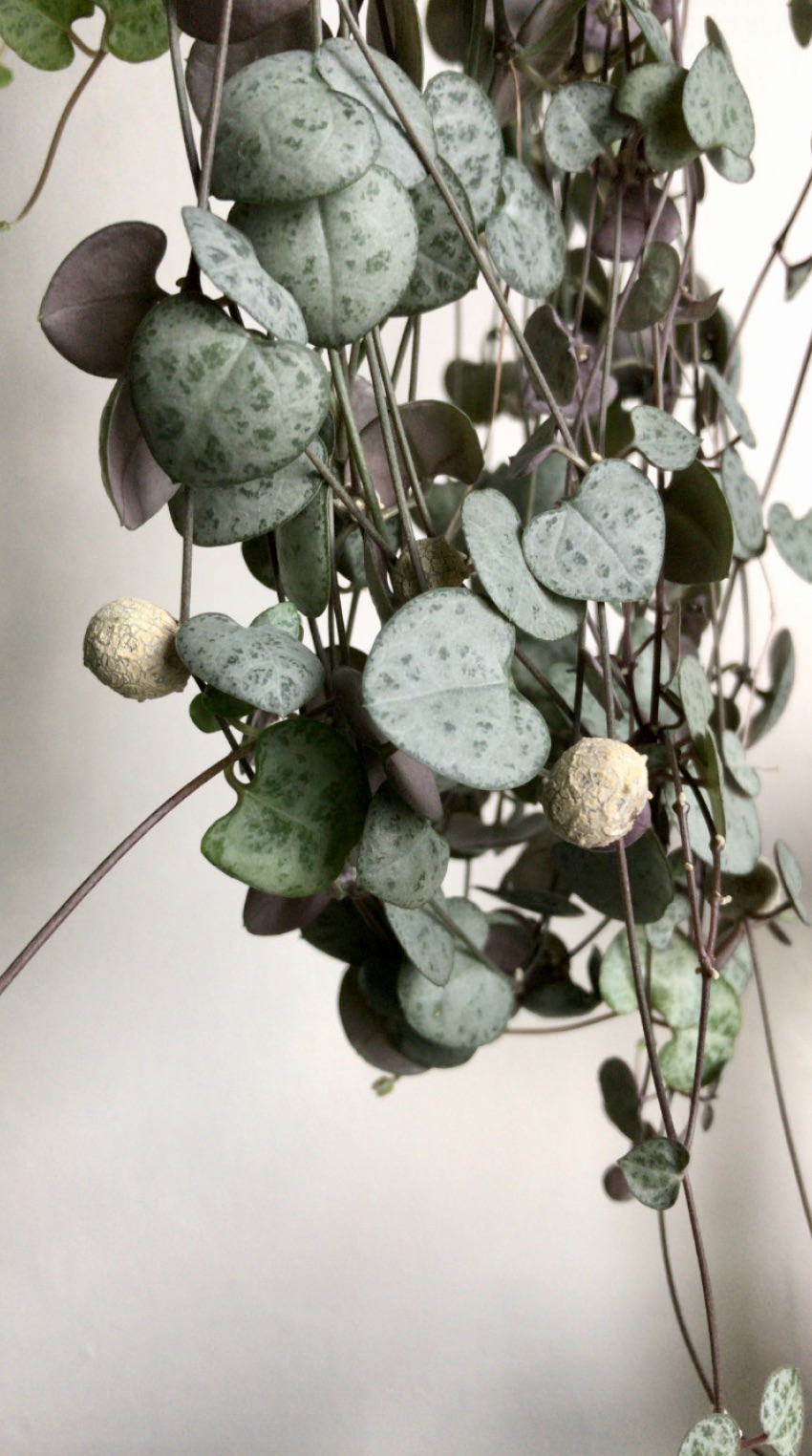
Watering
After the (almost) obligatory rotting of a few succulents when I started keeping plants a few years ago from incorrect watering, I decided to start watering a lot of my succulents from below. As tempting as it is to soak this plant through the top in situ (as it looks a pain-in-the-butt to get down from that hanger…) this plant will thank you for giving it a bit more tender loving care. The main reason these plants die is from overwatering so until you are more confident with how much + how often, I’d advise starting out by watering from below. I take mine down every two — three weeks (less in winter) and place on a tray of tepid water — very cold water will shock the roots. Leave to sit for 30—45mins + top the tray up with water if necessary. The hearts will start to look deflated if they are very thirsty. Every few waterings I will put the plant in the sink + flush it right through to make sure all the potting mix is getting wet. I’ll go a bit more into potting mix later on…

Fertilising
Feeding your plants properly is something that I learned off my grandpa — after years of helping him in the greenhouse feed his tomatoes. It seems an intrinsic aspect of plant care to me but I know that not everyone uses fertiliser, especially if you are new to keeping plants — largely from fear of not knowing what to buy / how much to use. Too much fertiliser can actually burn or even kill your plants so always read the label + I would recommend using at half strength to the dilution instructions. In short though, I generally use a 5-5-5 (NPK: Nitrogen-Phosphorus-Potassium) balanced fertiliser for my houseplants (sometimes I’ll use a feed for succulents but not always) + feed my string of hearts once every fortnight in the same way that I water them. I follow a ‘FRIDAY FEED’ routine every 1- 2 weeks during April + October (a routine passed on by my grandpa too). As a note here, if your climate is quite different to mine + you find your plants grow year-round, then more regular fertilising is fine (into Autumn + Winter). The easiest way to judge whether or not to feed is if your plant is actively growing. Regular feeding helps keep your plants strong + more resistant to pests. In terms of pests, look out for mealy bugs if the conditions have been warm + the plant allowed to dry out too much.
Repotting
The most common size of these I see around are little 9cm pots + I would generally advise to repot these as soon as they are settled in your home. These pots also usually come in tall plastic sleeves, which the plant doesn’t like as the humidity on the leaves isn’t great for them (side note — don’t mist them). I have found my hearts prefer a shallow pot than a deep one because they have a fine root structure + a light, free-draining potting mix to help prevent root rot. For my hearts, I use a potting mix of houseplant compost, orchid bark, coco coir, perlite + horticultural grit. If you have a cacti + succulent potting mix this would be a good alternative. I recently repotted my large string of hearts which was a bit of a task but I’ve noticed the plant is much happier since doing so, so always check your roots!


Propagation
If you follow these tips + your hearts flourish you might find that they get a bit long for the space that you have them… mine hit the floor a few weeks ago. So you can either let them keep growing, or make a new plant/ fill out your current plant by chopping + propagating cuttings. I cut + remove the hearts from the bottom ten centimetres of the strands – the nodes where the hearts have been removed will be where the roots grow from. After leaving the end of the stem to callus over for a few days, I place in water + leave for a few weeks in indirect light to root, somewhere warm + bright is good. Change the water every 7-10 days + if its warm, keep an eye on the water level in case it evaporates.
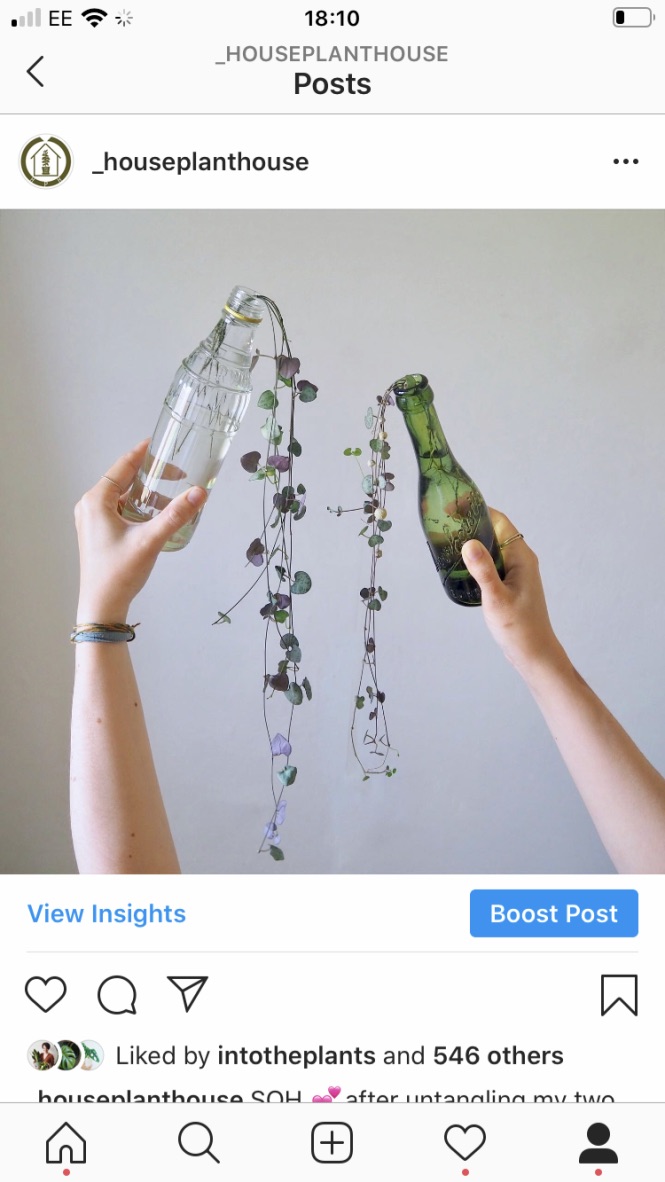


When your stems have rooted you can either create a new plant with them, or add them back into the top of the pot to make a fuller plant like this:




The other propagation option is a horizontal method as opposed to a ‘vertical’ method as mentioned above. If the top of your planter gets good amounts of light you can curl a stem (that is still attached to the main plant) around the top of pot. I have found this a great method for smaller pots that can sit on a table top or shelf + if the stems aren’t too long! Alternatively, if you want to take cuttings for this, you can do this by placing the cut stems on top of a layer of potting mix/sphagnum moss (whichever you prefer).
You can use an unfolded paper clip or similar to hold the loose stems in place until they have rooted if things feel a little loose. This method is sometimes called the butterfly method because the pairs of ‘hearts’ look like little butterflies sitting on top of the potting mix… I learned this a few years ago from a lovely elderly plant customer + thought the name was so sweet. Either way, these plants are really enjoyable to keep + experiment with propagating!
I hope this post will help to keep your string of hearts happy.


Leave a Reply